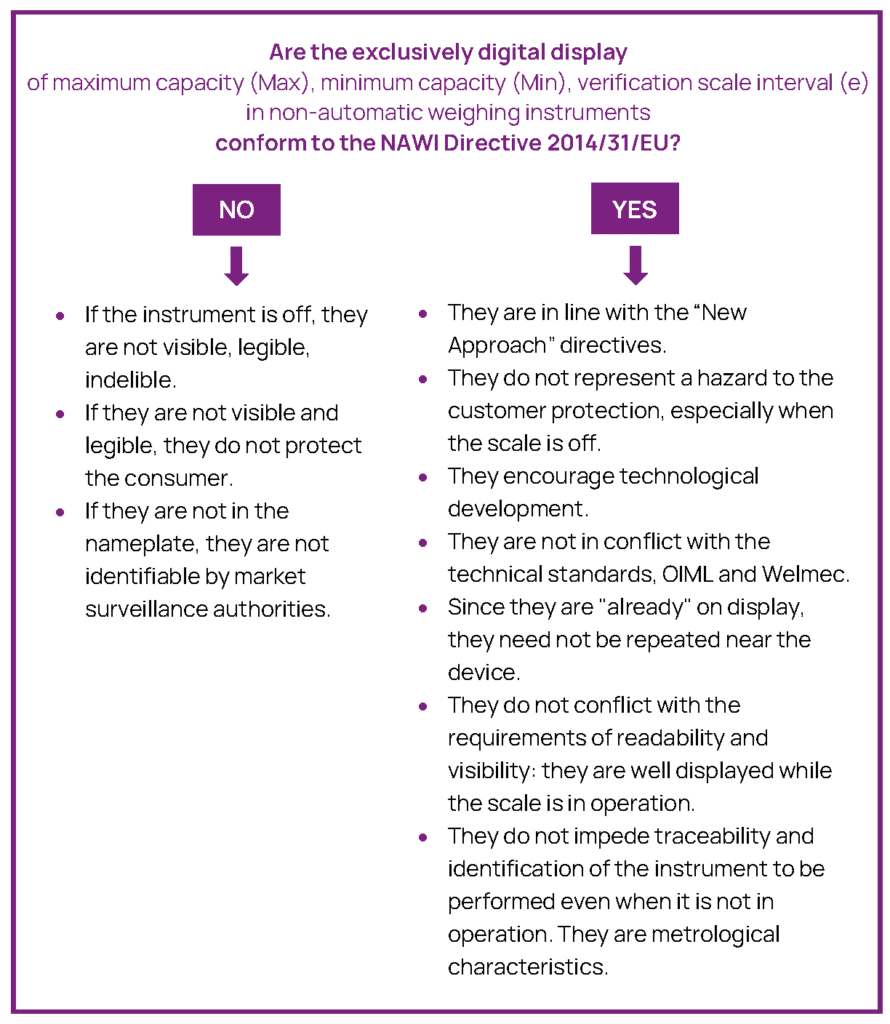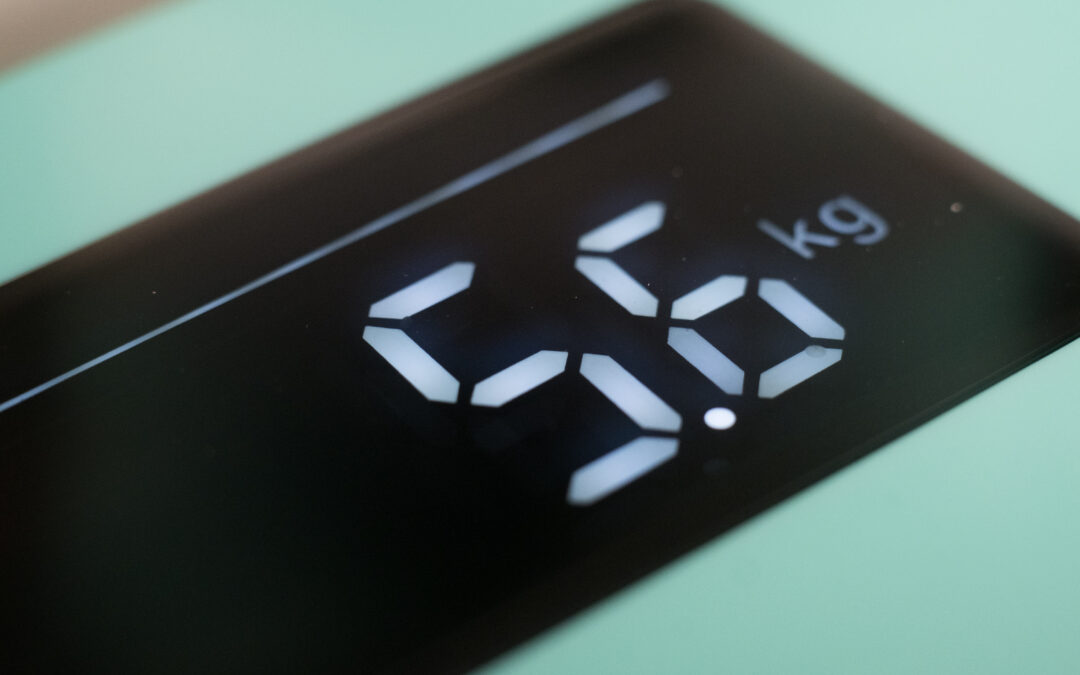Is it acceptable that in non-automatic weighing instruments (NAWI) the inscriptions of maximum capacity (Max), minimum capacity (Min) and verification scale division (e) are only visible in the display, thus only when the instrument is in operation?
How can this digital feature be compatible with the requirements of visibility, legibility and indelibility? Or do they have to be indicated in a label on the instrument?
Does the fact that they are not visible and legible when the instrument is switched off, since they are digital-only, cause damage to public faith and consumer protection?
While the answers to these questions might still have been doubtful until a few months ago, there is now an explicit ruling by a European State that not only clarifies this issue, but also paves the way for digital in the world of measuring instruments in general.
Let’s proceed in order.
The background. The issue arose during an inspection by the market surveillance authority in Germany. The manufacturer of a type of NAWI with exclusively digital inscriptions of Max, Min and e was accused of not complying with the NAWI Directive 2014/31/EU, Annex III, 1.1, because it did not meet the requirements of visibility, legibility and indelibility when the instrument was switched off, and there was not even an external label affixed to it, which showed them.
The surveillance authority therefore banned the placing on the market of that type of NAWI with inscriptions exclusively digital displayed, unless the manufacturer had not affixed an analogue external plate.
The manufacturer appealed to the court and if he lost in the first instance, in the second instance, an exemplary ruling of the High Administrative Court (see Resources) agreed with and gave very useful reasoning for future normative development.

Why should the answer be “no”, digital-only inscriptions do not fulfil the requirements of visibility, legibility and indelibility set out in NAWI Directive 2014/31/EU?
First, because it states in Annex III, 1.1, that the NAWI “shall bear visibly, legibly and indelibly the following inscriptions: …IV) maximum capacity, in the form Max …, V) minimum capacity, in the form Min …, VI) verification scale interval, in the form e = …”. When the instrument is switched off, they are not present unless they are written on a physical plate on the scale itself.
Furthermore, because the NAWI Directive 2014/31/EU, Annex III, 1.2, requires that “Those instruments shall have adequate facilities for the affixing of the conformity marking and inscriptions. These shall be such that … the conformity marking and inscriptions shall be visible when the instrument is in its regular operating position”. Digital-only inscriptions would seem not to fulfil this requirement by not being ‘affixed‘ on the instrument.
Then, because the NAWI Directive 2014/31/EU, Annex III, 1.3, requires a sealable data plate where the control mark can be affixed. The exclusively digital inscriptions are not present on the analogue physical plate, and are therefore not identifiable by the European market surveillance authorities. Think of situations where these authorities are unable to connect the scales to the electrical circuit for the inspection, i.e. when checking imported scales at ports and customs offices.
Finally, because digital-only inscriptions do not protect the end user as purchaser of the products.
The answer, however, is “yes”, the digital-only inscriptions of maximum capacity (Max), minimum capacity (Min) and verification scale interval (e) comply with the NAWI Directive 2014/31/EU and more!
The reasons can be grouped into these three macro topics: the general ratio of the European New Legislative Framework, which inspires and guides the product directives and the related national legislations; the approach of the technical standards, OIML, Welmec and the NAWI Directive 2014/31/EU itself; the difference between traceability, conformity, instrument identification, and indication of metrological characteristics.
Let us look at them in detail.
The first reason is the most important one, and from it follow, as a logical corollary, the interpretations of unclear sentences in the various normative texts, including the NAWI Directive 2014/31/EU itself. This is the general ratio of the European New Legislative Framework, which inspires and guides the so-called ‘New Approach’ directives from 2016 onwards. In practice, the inspiring principles of the European product directives are: to remove obstacles to the free movement of goods and technological progress, to protect public faith and the end users, and to ensure transparency in commercial transactions.
The exclusively digital inscriptions of maximum capacity (Max), minimum capacity (Min) and verification scale interval (e) do not impede the pursuit of the aims of the European New Legislative Framework, nor do they pose a hazard to consumer protection, especially when the scale is not in operation. On the contrary, they promote technological development.
The approach of the technical standards, OIML, Welmec and the NAWI Directive 2014/31/EU itself, on a more careful analysis, does not oppose exclusively digital inscriptions of maximum capacity (Max), minimum capacity (Min) and verification division (e) in non-automatic weighing instruments. They do not express any conflicting intention of the regulator, nor do they require the exclusive use of analogue markings for these types of inscriptions.
The OIML Recommendation R76 ed. 2006, paragraph 7.1.4 (issued long before the NAWI Directive 2014/31/EU), the technical standard EN 45501 ed. 2015 and the Welmec Guide 2 even recognise this solution as ‘acceptable’.
The NAWI Directive 2014/31/EU, which is based on these technical standards, does not in fact place any explicit vetoes, and we note this in the items highlighted below.
- The Annex III, 1.4, states that “the inscriptions Max, Min, e, and d, shall also be shown near the display of the result if they are not already located there”; being ‘already’ present in the display, they do not need to be repeated.
- It does not explicitly prohibit the exclusive reproduction of the required information in an electronic display.
- Digital inscriptions do not conflict with indelibility; on the contrary, they guarantee it precisely because the software is sealed and conforms to the requirements of inalterability and protection against misuse.
- Digital inscriptions do not conflict with the characteristics of legibility and visibility: they are well present during the operation of the weighing instrument.
- No reason can be found in the text of the directive that requires the information to be permanently visible even when the scale is switched off, when it cannot cause any damage, and this information is not useful for identifying the NAWI.
- The directive does not expressly require physically analogue labelling of Max, Min and e.
An important consideration, in the end, is the difference between traceability, conformity, identification of the instrument, and indication of its metrological characteristics, clearly described in OIML Recommendation R76 ed. 2006.
Details of the manufacturer (company name, address, etc.) and of the NAWI identification (serial number, type name, etc.) are essential for the instrument’s traceability, as is the supplementary metrology marking to verify its compliance with the NAWI Directive 2014/31/EU. This information is also essential when the instrument is not in operation, and must be contained on an identification plate or otherwise permanently affixed to the instrument.
Another matter concerns the metrological characteristics of the scale, which can be displayed permanently via a software solution (as required by technical standards) or by manual control, as an alternative to the possibility of printing them on an identification plate or sticker.
The inscriptions of Max, Min and e are metrological characteristics of the instrument and do not contribute to its immediate traceability and identification even when it is not in operation. It follows that being exclusively digital does not hinder the traceability and the identification of the instrument.
In conclusion, we can state that the judgment’s main grounds for confirming the conformity with the NAWI Directive 2014/31/EU of the exclusively digital inscriptions of maximum capacity (Max), minimum capacity (Min) and verification scale interval (e) in non-automatic weighing instruments, pave the path, now traced and unstoppable, towards the acceptance of increasingly digital solutions for measuring instruments in the reference normative (including the MID Directive 2014/32/EU) and contribute to resolving dubious interpretative issues for technological solutions not yet standardised.
Resources
- WELMEC, the European Cooperation in Legal Metrology.
- Justice of the state of North Rhine-Westphalia, Higher Administrative Court of North Rhine-Westphalia, Judgment nr. 4 A 1278/21 dated 8/09/2022.
- NAWI Directive 2014/31/EU.
- OIML R76 ed. 2006 Recommendation, Non-automatic weighing instruments.
- European norm EN 45501 ed. 2015, Metrological aspects of non-automatic weighing instruments.
- The ‘Blue Guide’ on the implementation of EU product rules 2022.
- EU Regulation 2019/1020 on market surveillance and compliance of products and amending Directive 2004/42/EC and Regulations (EC) No 765/2008 and (EU) No 305/2011.



